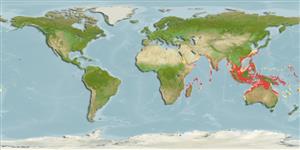Environment: milieu / climate zone / depth range / distribution range
Ecología
marino; salobre demersal; anfidromo (Ref. 51243); rango de profundidad 10 - 100 m (Ref. 12260). Tropical; 30°N - 30°S
Indo-West Pacific: from India to Papua New Guinea; north to Japan; south to Australia,
Length at first maturity / Tamaño / Peso / Age
Maturity: Lm 9.4 range ? - ? cm
Max length : 23.0 cm TL macho / no sexado; (Ref. 12260); common length : 15.0 cm TL macho / no sexado; (Ref. 5450); edad máxima reportada: 2.30 años (Ref. 4544)
Espinas dorsales (total): 8; Radios blandos dorsales (total): 16; Espinas anales 3; Radios blandos anales: 14; Vértebra: 24. This species of the Leiognathus splendens complex is distinguished by the following characters: no scales on cheek; anterior dorsolateral body surface almost completely scaled without a semicircular naked area on nape; lower margin of inner preopercular ridge is smooth or weakly serrated (including the neotype); interspace of pelvic keels without scales; second spines of dorsal and anal fins are robust (width of second spines of dorsal and anal fins 0.87-1.6% of SL and 0.76-1.7% of SL, respectively); a jet black blotch on spinous dorsal fin (Ref. 75583).
This schooling species inhabits coastal waters. It feeds on fish, crustaceans, foraminiferans, and bivalves (Ref. 5213). The annotated bibliography of Leiognathidae by Pauly and Wade-Pauly (Ref. 4961) includes 172 references pertaining explicitly to Leiognathus splendens.
Lipid stored in muscles, liver and intestine decreased during gonadal maturation and following spawning (Ref. 3655).
Kimura, S., T. Ito, T. Peristiwady, Y. Iwatsuki, T. Yoshino and P.N. Dunlap, 2005. The Leiognathus splendens complex (Perciformes: Leignothidae) with the description of a new species, Leiognathus kupanensis kimura and Peristiwady. Ichthyol. Res. 52 (3):275-291. (Ref. 75583)
IUCN Red List Status (Ref. 130435)
Human uses
Pesquerías: comercial
Más información
ReferenciasAcuiculturaPerfil de acuiculturaRazasGenéticaElectrophoresesheritabilidadEnfermedadesProcesamientoNutrientsMass conversion
Herramientas
Special reports
Download XML
Fuentes de Internet
Estimates based on models
Preferred temperature (Ref.
123201): 24.8 - 29.1, mean 28.1 °C (based on 1680 cells).
Phylogenetic diversity index (Ref.
82804): PD
50 = 0.5625 [Uniqueness, from 0.5 = low to 2.0 = high].
Bayesian length-weight: a=0.01950 (0.01525 - 0.02494), b=2.97 (2.90 - 3.04), in cm total length, based on LWR estimates for this species (Ref.
93245).
Nivel trófico (Ref.
69278): 2.9 ±0.38 se; based on food items.
Generation time: 1.2 (1.0 - 1.4) years. Estimated as median ln(3)/K based on 22
growth studies.
Resiliencia (Ref.
120179): Alto, población duplicada en un tiempo mínimo inferior a 15 meses (K=0.33-1.60; tm=1; tmax=2.3).
Fishing Vulnerability (Ref.
59153): Low vulnerability (15 of 100).
Nutrients (Ref.
124155): Calcium = 301 [127, 1,001] mg/100g; Iron = 1.94 [0.82, 4.73] mg/100g; Protein = 18.3 [16.3, 20.6] %; Omega3 = 0.231 [0.128, 0.423] g/100g; Selenium = 125 [48, 357] μg/100g; VitaminA = 4.78 [0.90, 27.87] μg/100g; Zinc = 2.33 [1.09, 4.14] mg/100g (wet weight); based on
nutrient studies.
